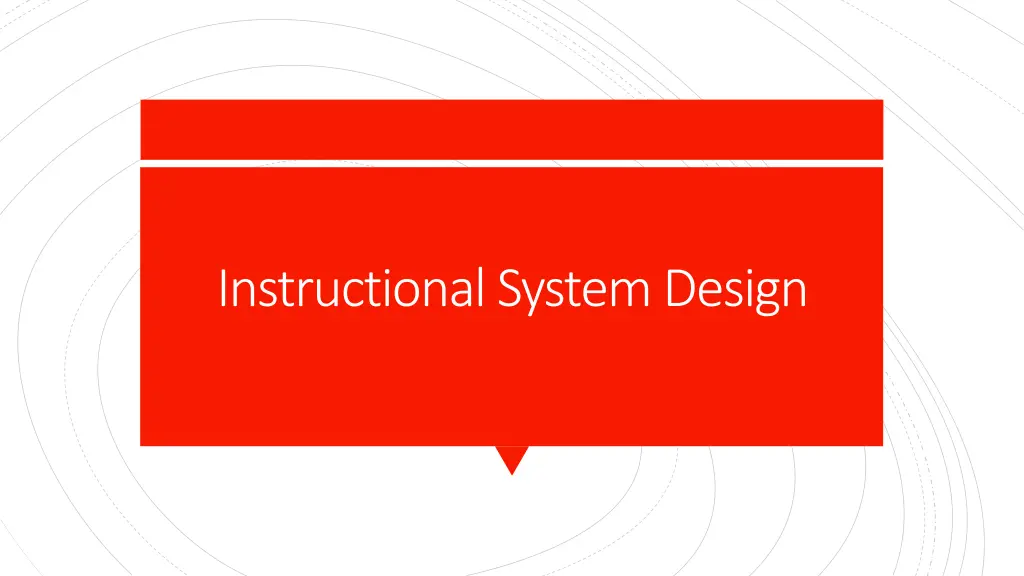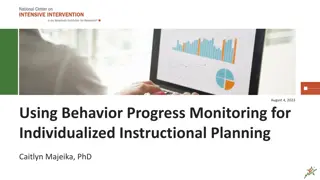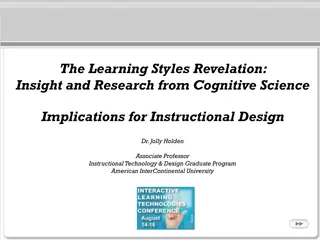
Effective Training Program Design for Enhanced Learning and Performance
Instructional System Design (ISD) is a systematic approach to developing training programs that target crucial learning needs, utilize appropriate methods, and improve on-the-job performance. This involves conducting a needs assessment, ensuring employee readiness, creating a conducive learning environment, and monitoring training effectiveness.
Download Presentation

Please find below an Image/Link to download the presentation.
The content on the website is provided AS IS for your information and personal use only. It may not be sold, licensed, or shared on other websites without obtaining consent from the author. If you encounter any issues during the download, it is possible that the publisher has removed the file from their server.
You are allowed to download the files provided on this website for personal or commercial use, subject to the condition that they are used lawfully. All files are the property of their respective owners.
The content on the website is provided AS IS for your information and personal use only. It may not be sold, licensed, or shared on other websites without obtaining consent from the author.
E N D
Presentation Transcript
The design of training programs should be systematic to ensure that they: Target the most important learning needs, Use the most appropriate methods, and Enhance on-the-job performance. Instructional System Design Defined Instructional System Design (ISD) is a linear, step-by-step process for developing training programs.
Step 3 - Create a learning environment that facilitates learning and transfer Step 4 - Ensure learning is transferred to the work environment Step 1 - Conduct a needs assessment Step 2 - Ensure that employees are ready for training Step 6 - Design and conduct the learning event Step 5 - Develop an evaluation plan Step 7 - Monitor and evaluate the training Conduct organizational, person, and task analyses Identify if training is needed Identify what kind of training is most valuable Take an inventory of trainees basic skills, motivation, and attitudes Ensure they have the qualifications to master the training content Plan program administration Shape learning culture Use learning objectives, meaningful material, practice, feedback, and modeling Encourage support from peers and managers Teach self- management strategies Measure various outcomes of training Measure the costs and benefits of training Prepare to calculate return on investment (ROI) Choose multiple traditional and e-learning training methods Consider the learning objectives and learning envir onment Deliver the training instruction Determine the effectiveness and strategic value of training Identify changes that can be made to improve training Steps of the Training Design Process
Step 1 - Conduct a needs assessment Conduct organizational, person, and task analyses Identify if training is needed Identify what kind of training is most valuable
Step 2 - Ensure that employees are ready for training Take an inventory of trainees basic skills, motivation, and attitudes Ensure they have the qualifications to master the training content
Step 3 - Create a learning environment that facilitates learning and transfer Plan program administration Shape learning culture Use learning objectives, meaningful material, practice, feedback, and modeling
Step 4 - Ensure learning is transferred to the work environment Encourage support from peers and managers Teach self-management strategies
Step 5 - Develop an evaluation plan Measure various outcomes of training Measure the costs and benefits of training Prepare to calculate return on investment (ROI)
Step 6 - Design and conduct the learning event Choose multiple traditional and e-learning training methods Consider the learning objectives and learning environment Deliver the training instruction
Step 7 - Monitor and evaluate the training Determine the effectiveness and strategic value of training Identify changes that can be made to improve training
ADDIE Model
1. It does not reflect the reality of training design, which rarely follows a neat and orderly plan. 2. Its linear nature does not provide much flexibility in the design process. Weaknesses of the ISD Model 3. It implies that training evaluation is the endpoint. 4. Its principles are sometimes applied incorrectly or insufficiently.
The training design process should be flexible enough to adapt to changing business needs. Applying the ISD Model Focus more on the components of each step and focus less on completing the steps in a purely linear fashion. Depending on the circumstances, the steps may be completed simultaneously.






















